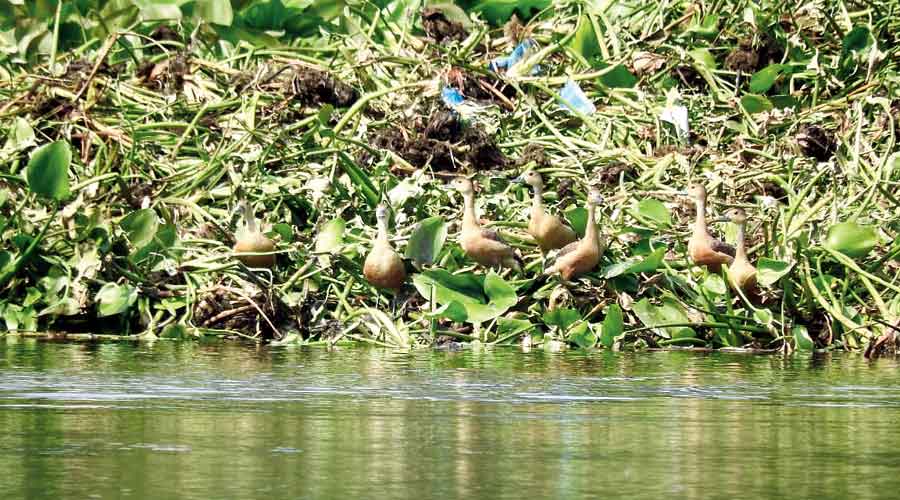The first batch of migratory birds has landed at Santragachhi Jheel in Howrah.
A group of birders spotted 12 Lesser Whistling Ducks roosting on water hyacinth islands at the water body on Friday. On Saturday, seven birds were spotted.
Lina Chatterjee, one of the birders who spotted the ducks, said they had spotted several other migrants but they circled the water body and had not yet come to roost.
Lesser Whistling Ducks are local migrants — they are native to the subcontinent and migrate from their breeding sites during winter — and have been recorded to be the dominant variety at the jheel.
“We spotted the ducks near a water hyacinth island and we clicked several photographs while they were roosting on the island. We went there on Sunday as well but they were not roosting there,” said Chatterjee.
She is part of a team of birding enthusiasts from Nature Mates, an organisation that has set up the water hyacinth islands at Santragachhi Jheel and has methodically cleaned the water to ensure the roosting places are not disturbed.
"If water hyacinth is removed when the migration season starts, the birds are likely to move away as the environment will not suit their needs," Chatterjee said.
More than 5,600 birds had been recorded at a census conducted at the Jheel last winter.
Prosenjit Dawn, who has been part of the census for more than 10 years and lives near the Jheel, said the news of the arrival of the ducks was quite exciting.
"A variety of migrants are spotted at the Jheel from November till February. The fact that Lesser Whistling Ducks have started roosting here is a signal that other birds will follow suit,” said Dawn.
Among the other local birds commonly sighted at the water body are Purple Herons and Common Moorhens.
Northern Pintails and Gadwalls, both trans-Himalayan migrants, are among the annual visitors to the Jheel. The guests from faraway lands include Gadwalls and Ferruginous Pochards, which breed in central Asia, China and Mongolia and fly thousands of miles to the subcontinent to escape the harsh winter there.
Last year, a Black Winged Stilt, another trans-Himalayan migrant that had never been known to have been sighted at Santragachhi, was seen at the water body in the first week of December.
Around 1,25,000 migratory birds fly every year from Siberia, China, east Europe and other parts of the world to wetlands here.
“We spotted the ducks near a water hyacinth island and we clicked several photographs while they were roosting on the island. We went there on Sunday as well but they were not roosting there,” said Chatterjee.
She is part of a team of birding enthusiasts from Nature Mates, an organisation that has set up the water hyacinth islands at Santragachhi Jheel and has methodically cleaned the water to ensure the roosting places are not disturbed.
“If water hyacinth is removed when the migration season starts, the birds are likely to move away as the environment will not suit their needs,” Chatterjee said.
More than 5,600 birds had been recorded at a census conducted at the Jheel last winter.
Prosenjit Dawn, who has been part of the census for more than 10 years and lives near the Jheel, said the news of the arrival of the ducks was quite exciting.
“A variety of migrants are spotted at the Jheel from November till February. The fact that Lesser Whistling Ducks have started roosting here is a signal that other birds will follow suit,” said Dawn.
Among the other local birds commonly sighted at the water body are Purple Herons and Common Moorhens.
Northern Pintails and Gadwalls, both trans-Himalayan migrants, are among the annual visitors to the Jheel. The guests from faraway lands include Gadwalls and Ferruginous Pochards, which breed in central Asia, China and Mongolia and fly thousands of miles to the subcontinent to escape the harsh winter there.
Last year, a Black Winged Stilt, another trans-Himalayan migrant that had never been known to have been sighted at Santragachhi, was seen at the water body in the first week of December.
Around 1,25,000 migratory birds fly every year from Siberia, China, east Europe and other parts of the world to wetlands here.
